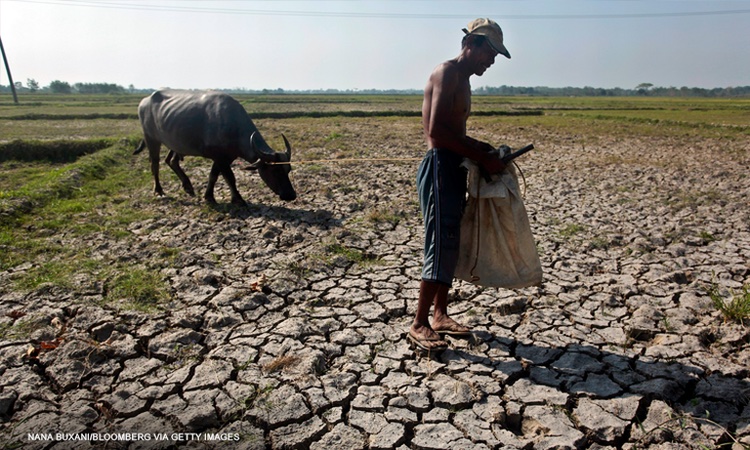
The impact of the El Niño phenomenon on Philippine agriculture has now resulted in P9.50 billion in damage, the Department of Agriculture (DA) disclosed on Tuesday, May 21.
The agency said that 13 regions across the country have been affected by the dry spell, including the Cordillera Administrative Region (CAR), Ilocos Region, Cagayan Valley, Central Luzon, Calabarzon, Mimaropa, Bicol Region, Western Visayas, Eastern Visayas, Zamboanga Peninsula, Central Mindanao, Davao Region, and Soccsksargen.
According to the DA, a total of 175,063 farmers and fisherfolk have been devastated by El Niño.
The agricultural areas affected by the phenomenon total 163,694 hectares, the agriculture department said.
“The increase in reported values include additional reports from Ilocos, Cagayan Valley, Central Luzon, Mimaropa, Western Visayas, Eastern Visayas, Central Mindanao, Davao and Soccsksargen regions,” the DA noted.
The agriculture department reported that production losses from the impacted agricultural areas are estimated at 185,561 metric tons (MT) for palay (rice), 180,807 MT for corn, 48,949 MT for high-value crops, and 147 MT for cassava, amounting to a total loss of 426,798 MT.
Per the DA, the affected rice area of 83,862 hectares represents 3.91 percent of the total target area of 2,137,046.77 hectares.
Meanwhile, the production loss of 185,561 MT is about 2.01 percent of the target production of 9,218,358.28 MT.
“As for corn, the area affected by the dry spell is at 66,950 hectares or 6.08 percent of the total target area planted of 1,101,695.90 hectares, while the production loss of 180,807 MT is 4.02% percent of target production of 4,493,026.90 MT,” the agency added.
The DA noted that they have provided P9.71 billion worth of interventions for fishers and farmers affected by the El Niño phenomenon.
Gearing for La Niña
Recently, the DA said it is now preparing for the La Niña phenomenon and has ordered its field offices across the country to prepare for adverse effects of heavy downpours, which it said, is expected to cause greater agricultural damage than the El Niño.
“Mas malaki yung damage ng La Niña [kumpara sa damage ng El Niño] ( The damage caused by La Niña is bigger compared to the damage caused by El Niño),” DA Assistant Secretary for Operations U-Nichols Manalo said, citing past episodes of the two weather phenomena.
According to him, the agency has been coordinating with farmer groups for drainage water management for farms.
The DA is now looking into areas that have been affected by La Niña in its past 16 episodes in the country, he added.
Rice harvest declined
DA spokesperson Assistant Secretary Arnel de Mesa said the rice harvest in the first quarter of the year declined by 100,000 MT due to the wrath of the El Nino phenomenon.
But the agriculture department said this is not bothersome as this is only less than one percent of the DA’s 20.4 million MT target harvest this year, noting that importation can “easily” augment the loss.
In a radio interview on May 5, De Mesa stated: “Bumaba nang bahagya ‘yung ating harvest noong first quarter by 100,000 metric tons. Pero ‘yun ay napakaliit, less than one percent. Kasi ‘yung ating harvest is 20.06 million MT last year (Our harvest decreased slightly in the first quarter by 100,000 metric tons. But that is very small, less than one percent. Because our harvest was 20.06 million MT last year).”
“Inaasahan natin ngayong taon ay mga 20.4 million metric tons so ‘yung nawala ay napakaliit na bahagi, mga one percent lamang and can be easily augmented by importation natin, 1.6 million metric tons na ‘yung pumasok (We expect this year’s harvest to be about 20.4 million metric tons so what was lost is a very small part, only about one percent and can be easily augmented by our importation, 1.6 million metric tons that came in),” he added.
Despite the havoc wreaked by El Niño on the country’s agriculture, De Mesa said the DA remains hopeful, foreseeing a bountiful harvest this year as a result of expanded seed variety distribution and government interventions.
The DA assured the public that the supply of the country’s primary staple is still enough.
On April 3, Agriculture Secretary Francisco “Kiko” Tiu Laurel Jr. said rice prices may not go down due to the agricultural damage caused by the El Niño phenomenon.
He said world rice prices are currently going down but due to the “lingering effects” of the phenomenon , it is unlikely for rice prices to decrease in the Philippines.